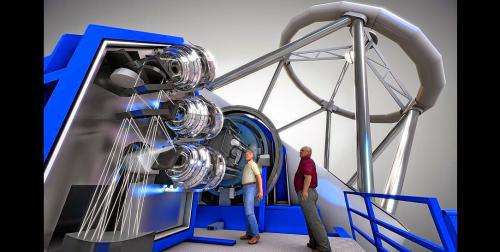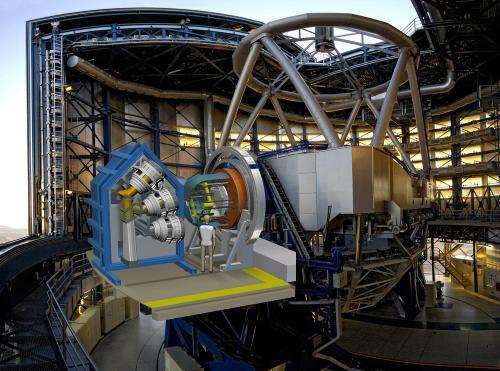Intergalactic GPS will guide you through the stars

Lost in the Universe? Need some precise navigation through the bulk of stars in the night sky? Don't worry, there will be an instrument for that - the Multi-Object Optical and Near-infrared Spectrograph (MOONS) at the European Southern Observatory's (ESO) Very Large Telescope (VLT) in northern Chile. The spectrograph, dubbed the intergalactic GPS, will help us navigate through the billions of stars in our galaxy and create a comprehensive map of its structure. "One of the first science cases is to help build up maps of the central region of our galaxy," William Taylor of the UK Astronomy Technology Centre (UK ATC) in Edinburgh, UK, told astrowatch.net. "With infrared light we have the power to see through the dust that obscures many of the objects in the central region of our galaxy, and so we can map the speeds and types of stars in the central bulge of the Milky Way."
The MOONS project is led by a team from UK ATC and the Royal Observatory in Edinburgh. The UK ATC will lead the Project Office managing the multinational consortium that will construct MOONS, and will also play a vital design role for key components.
"There's a host of different countries building parts of MOONS; Italy, France, Switzerland, Portugal and Chile," Taylor said. "The UK is leading the project and will be responsible for putting it all together here in Edinburgh before shipping it south to Chile. The other major UK partner in building the thing is the University of Cambridge."
MOONS is a large field (500 square arcminutes), multi-object (500 object + 500 sky fibers) instrument with spectral resolution of 5000 and 20 000 proposed for the VLT Nasmyth focus. It will allow astronomers to see obscured areas in the Milky Way at a distance of around 40,000 light years away, and enable them to create a 3D map of our galaxy.
"It can record spectra of many objects simultaneously. It does this by using small robotic arms to position 1000 fibers at the back of the telescope. The optical fibers connected to the VLT feed the light into a van-sized spectrograph. Once in the spectrograph, the light is split into its constituent parts, much like water droplets can split sunlight into its constituent colors and form a rainbow," Taylor explained. "MOONS will look at light from objects that extends from what our eyes see as red, to the region of the infrared, where our eyes seize to be sensitive."

MOONS will use the color of light emitted by objects to reveal their chemical composition, mass, speed and other properties. Breaking new ground by simultaneously observing 1000 objects using fiber-optic cables to feed their visible and infrared light into the instrument, it will survey large samples of objects far faster than any existing instrument and conduct surveys that would be virtually impossible using today's technologies.
Michele Cirasuolo of the UK ATC, the Principal Investigator of the MOONS project revealed that the instrument would be able to pioneer a wide range of galactic, extragalactic and cosmological studies and provide crucial follow-up for major facilities such as ESA's Gaia mission, the Visible and Infrared Survey Telescope for Astronomy (VISTA), Euclid spacecraft and the Large Synoptic Survey Telescope (LSST).
MOONS will complement the ongoing and planned surveys including the new large Gaia-ESO public spectroscopic survey. The unique features of MOONS will clarify the nature of the extinct regions of the Bulge, but will also assess the chemo-dynamical structure of the Thin and Thick Disc, understand the importance of satellites and streams in the Halo, ultimately creating an accurate 3D map of our Galaxy to provide essential insight into its origin and evolution.
MOONS will also be a powerful instrument to unveil 'the redshift desert' and study this crucial epoch around the peak of star-formation, the assembly of the most massive galaxies, the effect of the environment and the connection with the shining of powerful active nuclei.
"We will also use MOONS to study distant galaxies. On large scales we evidence for the alignment of galaxies, knowledge of which helps us to understand what our Universe is made of. Due to the expansion of the Universe, light emitted from the more distant galaxies is red-shifted into the infrared and so we really need something like MOONS to map out large portions of the galaxy," Taylor noted.
The instrument is scheduled to become operational by 2019. Once MOONS is up and running, the international consortium will receive 300 nights of observations using the instrument. In particular, this will benefit two ground-breaking projects: one to produce an unprecedented sophisticated survey of the center of the Milky Way; the other to look far back in time at ultra-distant galaxies to uncover the secrets of their early evolution.
"In terms of exploiting the science that we can do with MOONS, we have interest from a whole host of UK universities - over 14 at the last count. When the UK invests in building an instrument like this, we get a number of guaranteed nights on the telescope in return. With the consortium's 300 nights on one of the world's largest telescopes we have the potential to do some huge surveys, with millions of objects," Taylor said. "The data from this instrument is going to keep UK scientists busy for many years to come."
Taylor also underlined the uniqueness of MOONS: "There are systems that gather light from lots of objects, but only in the visible wavelengths of light. Equally, there are some devices that gather light from a few objects in the infrared. MOONS will be the first to do both. Well, maybe the first - the Japanese are building something similar to go on their telescope in Hawaii. I'm not saying it is a race, but we'd like to be first! The trouble is IR instruments are generally more expensive than visible ones, and so things like MOONS are rare beasts," he concluded.
Source: Astrowatch.net




















